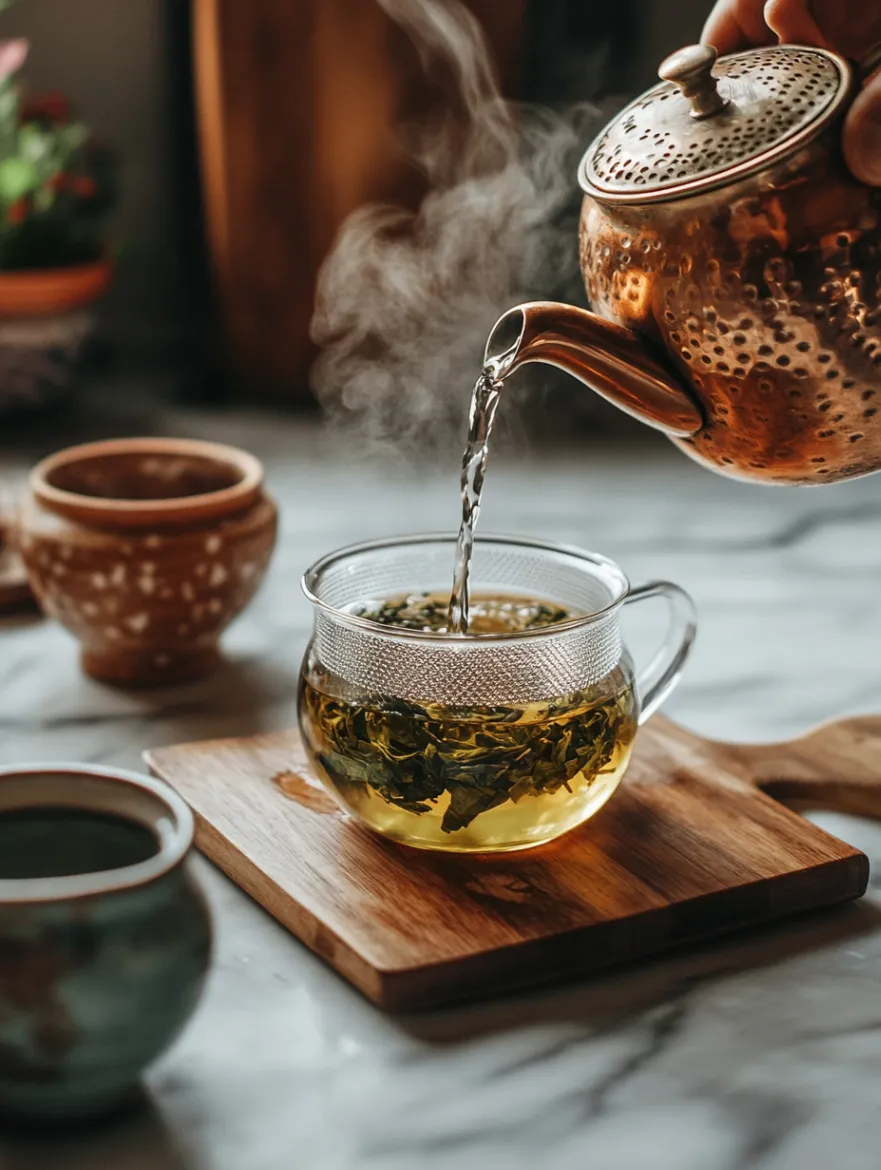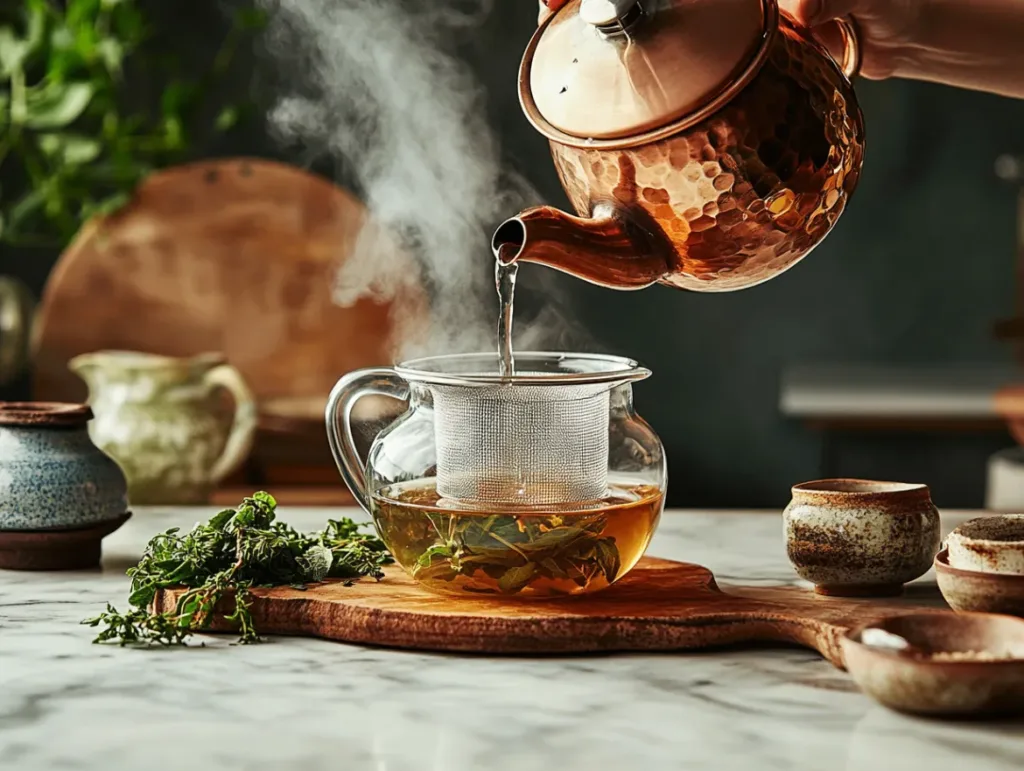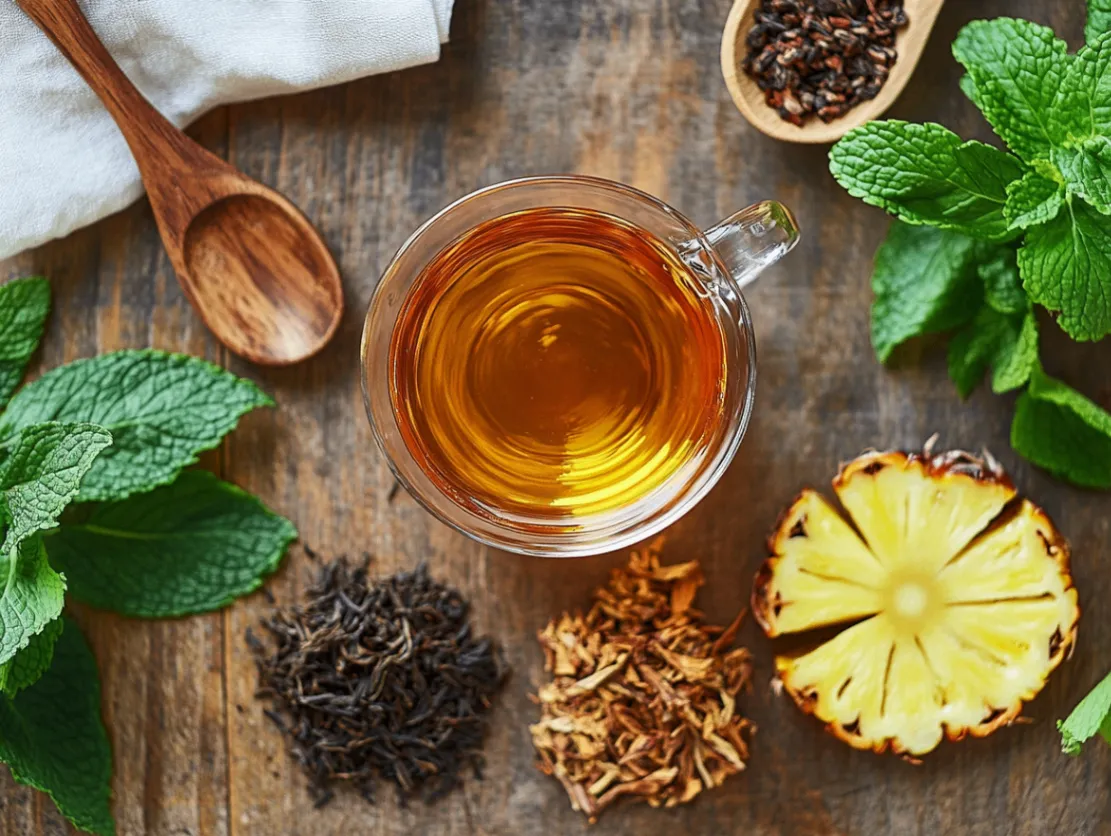Table of Contents
Table of Contents
When I first discovered Costa Rican tea during a transformative trip to the lush mountains of San José three years ago, I never imagined it would become such a cornerstone of my daily wellness routine. Picture this: I was sitting in a small café overlooking the cloud forests, feeling overwhelmed by the stresses of modern life, when an elderly local woman named Esperanza approached me with a steaming cup of the most aromatic, golden-hued tea I’d ever encountered. “Té para la vida,” she whispered with a knowing smile – tea for life.
That first sip of Costa Rican tea was nothing short of magical. The complex flavors danced on my palate – earthy, slightly sweet, with hints of tropical fruit and a warming spice that seemed to awaken every cell in my body. But what truly amazed me was how energized and balanced I felt afterward, as if my entire system had been gently reset. Esperanza explained that this traditional Costa Rican tea recipe had been passed down through generations of her family, cherished not just for its incredible taste but for its remarkable ability to support natural weight loss and overall vitality.
Since returning home, I’ve made this Costa Rican tea recipe a daily ritual, and the results have been absolutely transformative. Not only have I experienced steady, sustainable weight loss (15 pounds in six months!), but I’ve also noticed improved digestion, better sleep, and a natural boost in energy that carries me through even the busiest days. Today, I’m thrilled to share Esperanza’s precious recipe with you, along with all the secrets I’ve discovered for making the perfect cup of this life-changing Costa Rican tea.

Costa Rican Tea Recipe for Weight Loss
Ingredients
Tried this recipe?
Let us know how it was!
The Power-Packed Ingredients Behind Costa Rican Tea
Understanding the Magical Components and Their Weight Loss Benefits
The beauty of Costa Rican tea lies in its carefully balanced blend of indigenous herbs and botanicals, each contributing unique properties that work synergistically to support your weight loss journey. At the heart of this recipe are five key ingredients that have been treasured by Costa Rican families for centuries.
The primary component is chan seeds (Salvia hispanica), which Costa Ricans have used long before the world discovered chia seeds. These tiny powerhouses are packed with omega-3 fatty acids, fiber, and protein that help you feel satisfied longer while boosting your metabolism. When steeped in hot water, chan seeds release a gentle mucilage that creates a wonderfully soothing texture.
Pineapple mint (Mentha suaveolens ‘Variegata’) is another essential ingredient that gives Costa Rican tea its distinctive tropical flavor profile. This aromatic herb not only adds a delightful sweetness without any added sugars but also contains compounds that aid digestion and help reduce bloating – a common concern for those on their weight loss journey.
The third crucial element is cas bark (Psidium friedrichsthalianum), harvested from the native Costa Rican guava tree. This bark contains natural tannins and antioxidants that support healthy metabolism and help regulate blood sugar levels, making it easier for your body to burn fat efficiently.
Hierba buena (native Costa Rican spearmint) provides a cooling, refreshing element that helps suppress appetite naturally while supporting digestive health. Unlike regular spearmint, this variety has a more complex flavor profile with subtle notes of eucalyptus and lemon.
Finally, annatto leaves (Bixa orellana) contribute a beautiful golden color and mild, peppery flavor while providing powerful antioxidants that support liver function – crucial for effective weight management and detoxification.
Sourcing the Finest Quality Ingredients for Maximum Benefits
Finding authentic ingredients for Costa Rican tea might seem challenging, but I’ve discovered several reliable sources that ensure you’re getting the highest quality botanicals. The key is understanding what to look for and where to find these treasured ingredients.
For chan seeds, seek out suppliers that specialize in Central American herbs and spices. Look for seeds that are plump, dark, and have a slightly nutty aroma. Avoid any that appear dusty or have a musty smell, as this indicates they may be old or improperly stored. I recommend purchasing from certified organic suppliers who can guarantee the seeds haven’t been treated with chemicals.
Pineapple mint can often be found at specialty herb nurseries or online botanical retailers. If you’re lucky enough to have a local Costa Rican or Central American market, they sometimes carry fresh pineapple mint during certain seasons. The leaves should be vibrant green with cream-colored edges and should release a strong, sweet fragrance when gently crushed.
Cas bark is the most challenging ingredient to source, but it’s worth the effort. I’ve found that connecting with Costa Rican tea importers or traditional medicine practitioners often yields the best results. The bark should be reddish-brown, aromatic, and break cleanly when snapped. Never use bark that appears moldy or has an off-putting odor.
For hierba buena and annatto leaves, Latin American grocery stores are your best bet. Many now carry dried versions of these herbs in their spice sections. Online retailers specializing in traditional Central American ingredients also offer these items, often with detailed information about their origins and harvesting methods.
When possible, I always recommend building relationships with local suppliers who understand the importance of quality and authenticity. Many are passionate about sharing their knowledge and can provide valuable insights into the best ways to prepare and store your Costa Rican tea ingredients.
Smart Substitutions and Creative Alternatives
While I always encourage using traditional ingredients for the most authentic Costa Rican tea experience, I understand that finding every component isn’t always possible. Over the years, I’ve experimented with various substitutions that maintain the essence and benefits of the original recipe while making it more accessible to home cooks everywhere.
For chan seeds, high-quality chia seeds make an excellent substitute. Use the same proportions and preparation methods, though you may notice a slightly different texture and a more neutral flavor profile. Black sesame seeds, soaked overnight and ground, can also work in a pinch, though they’ll create a nuttier flavor profile.
If pineapple mint proves elusive, try combining regular spearmint with a small amount of dried pineapple pieces. The ratio should be about 3:1 mint to pineapple. Fresh pineapple sage is another wonderful alternative that provides similar tropical notes with additional beneficial compounds.
Cas bark can be substituted with a combination of cinnamon bark and dried guava leaves. Use half the amount of cinnamon bark called for in the original recipe, combined with an equal amount of guava leaves. This creates a similar tannin profile and provides comparable metabolic benefits.
For hierba buena, any high-quality spearmint will work, though you might want to add a small amount of fresh lemon verbena to replicate the complex flavor profile of the Costa Rican variety. The key is using fresh or recently dried herbs rather than old, flavorless ones.
Annatto leaves can be replaced with turmeric root and a small amount of paprika for color, though the flavor will be quite different. Alternatively, hibiscus flowers provide beautiful color and beneficial antioxidants, though they’ll add a tart flavor that changes the overall profile of your Costa Rican tea.
Remember, the beauty of this recipe lies in its flexibility and the love you put into preparing it. Even with substitutions, you’ll still create a delicious, beneficial tea that supports your weight loss goals and overall wellness.
Mastering the Art of Costa Rican Tea Preparation
Essential Prep Work and Ingredient Preparation
The secret to exceptional Costa Rican tea begins long before you put the kettle on. Proper preparation of your ingredients is crucial for extracting maximum flavor and benefits from each component. I’ve learned that taking time with these preliminary steps makes the difference between a good cup of tea and an absolutely transformative one.
Start by examining each ingredient carefully. Chan seeds should be rinsed in cool water using a fine-mesh strainer, removing any debris or damaged seeds. After rinsing, spread them on a clean kitchen towel and let them air-dry for about 30 minutes. This process removes any residual dust and ensures they’ll release their beneficial oils more effectively during steeping.
Fresh pineapple mint leaves require gentle handling to preserve their delicate volatile oils. If you’re using fresh leaves, avoid washing them until just before use, as excess moisture can cause them to deteriorate quickly. When ready to prepare your Costa Rican tea, rinse the leaves briefly under cool water and pat them dry with paper towels. For dried pineapple mint, simply check for any stems or foreign matter and remove them.
Cas bark needs special attention as it’s quite hard and requires some processing to release its beneficial compounds. I like to break larger pieces into smaller fragments using a mortar and pestle or a clean hammer wrapped in a kitchen towel. The pieces should be roughly the size of a fingernail – large enough to strain out easily but small enough to allow proper extraction.
Hierba buena leaves, whether fresh or dried, should be bruised gently to release their aromatic oils. I do this by placing the leaves between my palms and rubbing them together gently, or by using the back of a spoon to press them lightly against the bottom of my tea preparation bowl. You’ll know you’ve done this correctly when you can smell the wonderful minty aroma filling the air.
Annatto leaves are typically used dried and may need to be broken into smaller pieces for optimal steeping. If you’re using fresh leaves, they should be handled similarly to the mint leaves – gently bruised to release their beneficial compounds.
The quality of your water is just as important as your ingredients. I always use filtered water for my Costa Rican tea because chlorine and other chemicals can interfere with the delicate flavors and potentially reduce the effectiveness of the herbs. The water should be heated to just below boiling – around 200°F (93°C) – which is hot enough to extract the beneficial compounds without destroying the more delicate components.
Step-by-Step Brewing Instructions with Secret Techniques
Creating the perfect cup of Costa Rican tea is an art form that I’ve refined through countless experiments and a few wonderful mistakes along the way. The key is understanding that each ingredient has its own optimal extraction time and temperature, which is why this recipe uses a specific layered brewing technique.
Begin by warming your teapot or brewing vessel with hot water, then emptying it completely. This ensures that your Costa Rican tea maintains its temperature throughout the brewing process. In the warmed vessel, add your cas bark pieces first, as they require the longest extraction time. Pour about one-third of your hot water over the bark and let it steep for 3-4 minutes. You’ll notice the water beginning to take on a lovely amber color and a subtle, woody aroma.
Next, add your chan seeds to the bark mixture. The seeds will begin to release their natural mucilage, creating a slightly thicker texture that helps carry the flavors of all the other ingredients. Let this combination steep for another 2-3 minutes, stirring gently once or twice to encourage the seeds to release their beneficial compounds.
Now comes the critical moment – adding the mint leaves. Add both the pineapple mint and hierba buena to your brewing vessel, followed by the remaining hot water. This is where my secret technique comes in: instead of simply letting everything steep together, I use a gentle swirling motion to create a small whirlpool in the teapot. This movement helps the mint oils distribute evenly throughout the liquid while preventing over-extraction, which can lead to bitterness.
The final step is adding the annatto leaves, which should be steeped for just 2-3 minutes to impart their beautiful color and mild flavor without overwhelming the other ingredients. During this final steeping period, I like to cover the vessel with a clean kitchen towel in addition to the lid – this extra insulation helps maintain temperature and prevents the loss of volatile oils through evaporation.
After the total brewing time of 10-12 minutes, strain your Costa Rican tea through a fine-mesh strainer into your serving cup or teapot. I always take a moment to inhale the incredible aroma before taking my first sip – it’s become a cherished part of my daily ritual that helps me feel connected to the wisdom of the Costa Rican mountains.
One of my favorite secret techniques is adding a small piece of crystallized ginger during the final steeping phase. This isn’t traditional, but it adds a warming element that enhances the weight loss benefits while providing a subtle spicy note that complements the other flavors beautifully.
Common Mistakes and How to Avoid Them
Through my years of perfecting this Costa Rican tea recipe, I’ve made just about every mistake possible – and learned valuable lessons from each one. By sharing these common pitfalls, I hope to help you create perfect cups of this transformative tea from your very first attempt.
The most frequent mistake I see is over-steeping the mint components. While it might seem logical that longer steeping would create stronger flavor, with mint varieties, this actually leads to a bitter, astringent taste that masks the subtle sweetness of the pineapple mint. Always stick to the recommended steeping times, and if you want a stronger mint flavor, use more leaves rather than extending the brewing time.
Another common error is using water that’s too hot or too cool. Water that’s actively boiling (212°F/100°C) will scorch the delicate mint oils and create an unpleasant bitter taste. Conversely, water that’s too cool won’t extract the beneficial compounds from the cas bark and chan seeds. I keep a candy thermometer handy until you develop a feel for the right temperature – the water should be just barely bubbling around the edges of the pot.
Many people make the mistake of crushing the chan seeds before brewing, thinking this will improve extraction. However, whole seeds release their mucilage and nutrients more gradually, creating a better texture and preventing the tea from becoming overly thick or gummy. If you want to enhance the extraction from chan seeds, try soaking them in room temperature water for 30 minutes before adding them to your Costa Rican tea.
Storage mistakes can also sabotage your tea-making efforts. I learned this lesson the hard way when I stored my cas bark in a humid location and it developed mold. All ingredients should be stored in airtight containers in a cool, dry place, away from direct sunlight. Dried herbs and bark can last for up to a year when properly stored, while fresh ingredients should be used within a few days.
Proportion errors are another common issue. The recipe ratios have been carefully balanced to create the optimal flavor profile and maximum benefits. While you can certainly adjust for personal taste preferences, dramatic changes in proportions can throw off the entire balance. If you find the tea too strong, dilute it with hot water rather than reducing the steeping time.
Finally, many newcomers to Costa Rican tea make the mistake of drinking it too quickly after brewing. Like fine wine, this tea benefits from a few minutes of breathing time after straining. The flavors continue to develop and meld together, creating a more complex and satisfying experience. I always let my tea sit for 2-3 minutes before taking that first, perfect sip.
Serving, Savoring, and Storing Your Costa Rican Tea
Creative Presentation Ideas for Every Occasion
One of the joys of Costa Rican tea is its natural beauty – the golden amber color and aromatic steam create an inherently appealing presentation. However, I’ve discovered several ways to elevate the visual experience that make this already special tea feel even more ceremonial and inviting.
For everyday enjoyment, I love serving Costa Rican tea in clear glass mugs that showcase its beautiful color. The transparency allows you to appreciate the subtle variations in hue that occur as the tea cools, and watching the gentle swirl of chan seed mucilage creates an almost meditative experience. I often garnish the rim of the glass with a small sprig of fresh mint or a thin slice of lime, which adds a pop of color and hints at the tropical flavors within.
When entertaining guests, presentation becomes even more important. I like to serve Costa Rican tea in my grandmother’s delicate porcelain teacups, accompanied by small bowls of crystallized ginger, raw honey, and lime wedges. This allows each person to customize their tea experience while creating an elegant, old-world atmosphere that honors the traditional roots of this recipe.
For special occasions, I’ve created what I call “Costa Rican tea flights” – small portions of the tea served at different concentrations in shot glasses, allowing guests to experience the full spectrum of flavors from light and refreshing to rich and complex. This presentation style always sparks conversation and helps people appreciate the nuanced complexity of Costa Rican tea.
During summer months, I love preparing Costa Rican tea as a refreshing iced beverage. I brew it at double strength, then pour it over ice cubes made from coconut water. The result is a gorgeous, layered drink that’s as Instagram-worthy as it is delicious. Fresh pineapple wedges and mint sprigs make perfect garnishes for this presentation.
For those interested in the spiritual aspects of tea drinking, I’ve developed a simple ceremony around Costa Rican tea that honors its traditional roots. I serve it in handmade ceramic cups, accompanied by a small plate of tropical fruits and nuts. The act of mindfully preparing and sharing the tea becomes a moment of gratitude and connection – exactly as Esperanza taught me during that first encounter in Costa Rica.
Perfect Pairings and Complementary Foods
The complex flavor profile of Costa Rican tea makes it wonderfully versatile for pairing with both sweet and savory foods. Over the years, I’ve discovered combinations that not only taste incredible but also enhance the weight loss benefits of this remarkable tea.
For breakfast, Costa Rican tea pairs beautifully with foods that support sustained energy and healthy metabolism. I love enjoying it alongside steel-cut oats topped with fresh berries and a drizzle of raw honey. The fiber in the oats works synergistically with the chan seeds in the tea to promote feelings of fullness, while the natural sweetness of the berries complements the tea’s tropical notes.
Greek yogurt with sliced almonds and a sprinkle of cinnamon makes another excellent breakfast companion. The protein in the yogurt helps stabilize blood sugar levels, while the healthy fats in the almonds provide sustained energy. The cinnamon echoes the warming spices in the Costa Rican tea and adds additional metabolic benefits.
For mid-morning or afternoon snacks, I’ve found that Costa Rican tea pairs wonderfully with tropical fruits that echo its flavor profile. Fresh pineapple chunks, mango slices, and papaya all complement the tea’s natural sweetness while providing additional digestive enzymes and vitamins. A small handful of macadamia nuts or cashews adds healthy fats that help with nutrient absorption.
When serving Costa Rican tea as an evening beverage, I like to pair it with lighter foods that won’t interfere with sleep. Cucumber sandwiches made with whole grain bread and herbed cream cheese provide a satisfying but not overly heavy option. The cooling properties of cucumber complement the mint in the tea, creating a refreshing end to the day.
For those who enjoy savory pairings, Costa Rican tea surprisingly works well with mild cheeses and whole grain crackers. The tea’s earthy undertones complement aged cheeses like manchego or aged gouda, while the natural acidity helps cleanse the palate between bites.
During weight loss phases, I’ve found that pairing Costa Rican tea with high-fiber, low-calorie foods helps maximize its appetite-suppressing effects. Raw vegetables with hummus, air-popped popcorn, or apple slices with a small amount of almond butter all work well. The key is choosing foods that complement rather than compete with the tea’s delicate flavors.
Storage Secrets and Reheating Techniques
Proper storage is crucial for maintaining both the flavor and beneficial properties of Costa Rican tea. I’ve learned through experience that different storage methods can dramatically affect the tea’s quality and shelf life, and I’m excited to share the techniques that have worked best for me.
For freshly brewed Costa Rican tea, the ideal storage method depends on when you plan to consume it. If you’re drinking it within 2-3 hours, simply covering the teapot or cup with a clean cloth is sufficient. The tea will actually continue to develop its flavors during this time, often tasting even better than when first brewed.
For longer storage, I always strain the tea completely and transfer it to a glass container with a tight-fitting lid. Glass is preferable to plastic because it doesn’t absorb flavors or odors, and it allows you to see the beautiful color of your Costa Rican tea. Stored this way in the refrigerator, the tea will maintain its quality for up to 48 hours.
When it comes to reheating, gentle methods preserve the tea’s delicate flavor compounds best. I never use a microwave, as the uneven heating can create hot spots that destroy beneficial compounds and create an unpleasant taste. Instead, I use a small saucepan over low heat, warming the tea slowly and stirring occasionally. The tea is ready when it’s steaming but not bubbling.
For a more traditional approach, I sometimes use a double boiler method, placing the tea in a heat-proof bowl over simmering water. This method takes longer but provides the most gentle, even heating. It’s especially important when reheating Costa Rican tea that contains chan seeds, as too much heat can make the mucilage unpleasantly thick.
An alternative approach I’ve developed is the “refresh method” – adding a small amount of freshly brewed, concentrated Costa Rican tea to the reheated portion. This technique restores some of the volatile compounds that may have been lost during storage and creates a more vibrant flavor profile.
For those who prepare large batches of Costa Rican tea, I’ve found that freezing portions in ice cube trays works wonderfully. The frozen tea cubes can be added directly to hot water for a quick cup, or used to make iced versions of the tea. This method is particularly useful during busy weeks when you want to maintain your Costa Rican tea routine without daily preparation.
One important note about storage: never store Costa Rican tea in metal containers, as this can cause the tannins from the cas bark to react and create an unpleasant metallic taste. Stick with glass, ceramic, or food-grade plastic containers for best results.
 DINNER
DINNER  LUNCH
LUNCH  Desserts
Desserts  BREAKFAST
BREAKFAST For more amazing recipes, be sure to check out our other sections to explore a variety of ideas that will enrich your cooking experience. Each section offers its own unique flavors to ensure a delightful culinary journey:
Easy and Quick Recipes: A collection of dishes that guarantee delicious meals with minimal effort and time.
Healthy Recipes: Discover healthy and delicious options that fit your lifestyle.
Desserts: A diverse selection of sweets that will add a special touch of sweetness to your table.
Lunch Recipes: Tasty lunch ideas that you can easily prepare to delight your family.
Dinner Recipes: Delicious and easy-to-make recipes that will make your dinner a memorable occasion.

Frequently Asked Questions About Costa Rican Tea
Q: How much weight can I realistically expect to lose drinking Costa Rican tea?
A: Weight loss with Costa Rican tea varies significantly from person to person, depending on factors like current diet, exercise habits, metabolism, and overall health. In my personal experience and from feedback I’ve received from friends who’ve tried this recipe, most people notice initial changes within 2-3 weeks, with more significant results after 2-3 months of consistent use. I lost 15 pounds over six months, but I also made other healthy lifestyle changes during that time. The key is consistency – drinking 1-2 cups daily while maintaining a balanced diet and regular physical activity. Remember, Costa Rican tea is a tool to support your weight loss journey, not a magic solution on its own.
Q: When is the best time of day to drink Costa Rican tea for maximum weight loss benefits?
A: I’ve experimented with different timing and found that drinking Costa Rican tea about 30 minutes before meals provides the best appetite-suppressing effects. The chan seeds and mint help you feel satisfied with smaller portions. Many people also enjoy it as a mid-morning or mid-afternoon drink to combat cravings and maintain energy levels. I personally drink one cup before breakfast and another in the late afternoon. Avoid drinking it too close to bedtime, as some people find the natural energy boost interferes with sleep, though others find the ritual relaxing.
Q: Can I drink Costa Rican tea if I have diabetes or other health conditions?
A: While Costa Rican tea contains natural compounds that may help regulate blood sugar levels, I always recommend consulting with your healthcare provider before adding any new herbal preparation to your routine, especially if you have diabetes, heart conditions, or take medications. Some ingredients in Costa Rican tea, particularly the cas bark, may interact with certain medications or affect blood sugar levels. Your doctor can help determine if this tea is appropriate for your specific situation and may want to monitor your blood sugar more closely if you decide to incorporate it into your daily routine.
Q: Are there any side effects I should be aware of when drinking Costa Rican tea?
A: Most people tolerate Costa Rican tea very well, but some may experience mild side effects, especially when first starting. The most common is slight digestive upset, usually due to the chan seeds’ high fiber content. Start with smaller amounts and gradually increase to allow your system to adjust. Some people also experience increased urination due to the natural diuretic properties of certain herbs in the blend. Very rarely, individuals with mint allergies may experience reactions. If you’re pregnant, nursing, or have sensitive digestion, start with a very weak preparation and monitor how you feel. Discontinue use if you experience any adverse reactions.
Q: How long can I safely drink Costa Rican tea, and should I take breaks?
A: Costa Rican tea is made from natural ingredients that have been consumed safely for generations in Costa Rica. However, I recommend taking a one-week break every 6-8 weeks to allow your body to reset and prevent developing a tolerance to the beneficial compounds. This approach has worked well for me and helps maintain the tea’s effectiveness over time. Long-term use appears to be safe for most people, but listen to your body and consult with a healthcare provider if you have any concerns. Some people cycle between Costa Rican tea and other herbal teas to maintain variety in their wellness routine while still enjoying the benefits.
Conclusion: Your Journey to Wellness Starts Here
As I sit here sipping my evening cup of Costa Rican tea, watching the golden liquid catch the last rays of sunset through my kitchen window, I’m filled with gratitude for that serendipitous encounter with Esperanza three years ago. This simple yet powerful recipe has become so much more than just a beverage in my life – it’s a daily ritual that connects me to the wisdom of generations, a natural ally in my wellness journey, and a delicious reminder that the most profound transformations often come from the simplest pleasures.
I encourage you to approach Costa Rican tea with an open heart and realistic expectations. While the weight loss benefits are certainly compelling, the true magic lies in how this tea can become a cornerstone of a healthier, more mindful lifestyle. Start slowly, pay attention to how your body responds, and allow yourself to enjoy the ritual of preparation as much as the drinking itself.
Remember, every expert was once a beginner. Don’t worry if your first few attempts don’t taste exactly like you imagined – mine certainly didn’t! The beauty of Costa Rican tea lies not in perfection but in the journey of discovery. Each cup is an opportunity to refine your technique, adjust the proportions to your taste, and deepen your connection to this ancient wisdom.
I’d love to hear about your own Costa Rican tea journey! Please share your experiences, variations, and discoveries in the comments below. Did you find creative substitutions that worked well? Have you noticed particular benefits that surprised you? Your insights could help fellow tea enthusiasts on their own paths to wellness.
Here’s to your health, happiness, and the transformative power of a perfectly brewed cup of Costa Rican tea. May it bring you as much joy, vitality, and positive change as it has brought to my life. ¡Salud!
